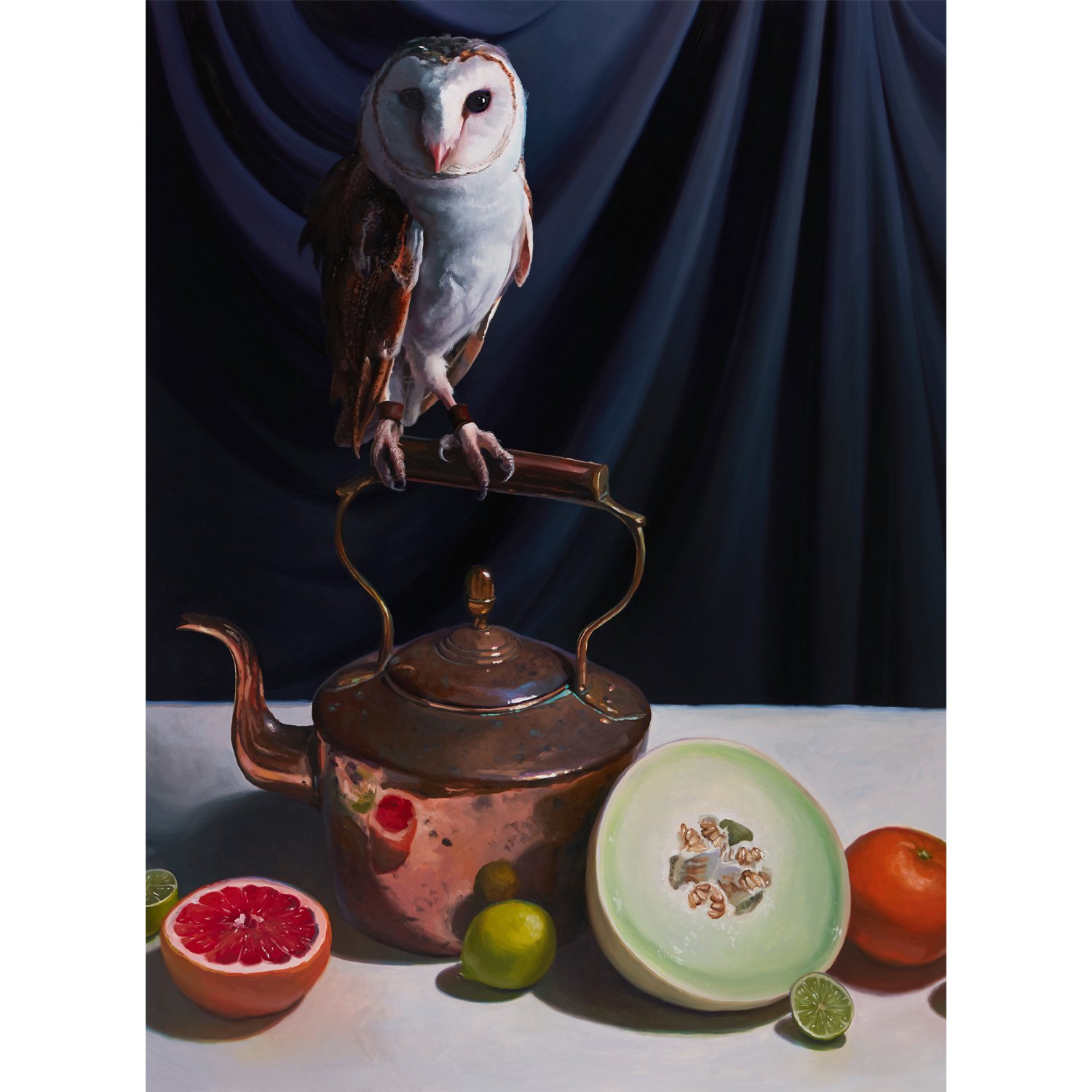“One small change” is a collection of paintings of wild raptors (Australian bird of prey) that have come into care due to injury or misfortune (with the exception of a Barn Owl who’s a free flying education bird at O’Rileys Rainforest Retreat).
One Small Change
14 April - 4 May 2023
Gallery One, QLD
Raptors are often high in the skies and rarely close enough for us to observe their personalities. By painting Australian bird of prey into domestic settings with familiar objects and antiques, I aim to help the viewer become acquainted with each individual raptor and to empathise with them. Once we as a society recognise the majesty and value of these incredible creatures (just like the value we place on antiques), I feel we will collectively make more ethical choices when it comes to protecting them.
The inspiration from this collection came when I learnt about the consequences of using rat baits. The theme “one small change” is based around the ideal that if each of us makes one small change regarding rat baits, we can boost our native raptor populations and subsequently reduce the risk of rodent plagues in future.
The most common rat baits available are second generation anticoagulant rodenticides (SGARs). These are very effective in poisoning their target species (mice and rats). However they also poison native small mammals (such as possums and bandicoots) and a second generation of non-target species (such as owls) that may eat the poisoned rodents (one BirdLife study found 97% of deceased Powerful Owls had anticoagulant rodenticides detected in their livers). SGARs are for native animal populations and they are banned in many countries. However in Australia they are readily available from most home-improvement stores.
Of course, in some circumstances rat baits are necessary. But I would like to encourage everyone to think twice before using SGARs as their first choice. Goodnature traps make an incredible automatic trap powered using compressed CO² gas which has no risk of secondary poisoning to non-target species such as wildlife or your pets! Because it’s automatic it nips any new rat problems in the bud, before you are even aware of them!
Traditional cage style rodent traps also work incredibly well (I have tried and tested these with great success). If they fail, first generation rat baits could next be considered (these contain the active ingredient Warfarin or Coumatetralyl). Second generation rat baits (actives ingredients Brodifacoum, Bromadialone and Difenacoum) should only be used as a last resort.
For more information on which rat bait ingredients to look for and their alternatives, please visit Actforbirds.org
For all artwork enquiries, please contact Gallery One.
Working with wild birds has been a real treat. The majority of my work to date has been with captive bred parrots. Raptors (particularly wild raptors) are a completely different experience. I've enjoyed observing the similarities and differences in their body language compared to parrots, particularly in relation to their eyesight, focus and use of their feet.
When photographing wild birds, I've had to be very conscious of not overwhelming them or desensitising them either. Ideally, human contact is kept to a minimum so I work quickly, keep my distance and work within a small window of opportunity to correct the lighting or camera settings. The photographs that result are completely at the will of the individual bird. I then take the images home and devise a composition based around what glimpse of personality the bird offered me on that day.
Anne
![Billy the One Eyed Kestrel [SOLD]](https://images.squarespace-cdn.com/content/v1/58e5944a3e00be09006bcdb9/1678759238000-SJZBTZ674ZHW9BKO9HNM/2022_billy-the-one-eyed-kestrel.jpg)
![Billy the One Eyed Kestrel (back view) [SOLD]](https://images.squarespace-cdn.com/content/v1/58e5944a3e00be09006bcdb9/1678759244175-5EGNRZ9LE18IRNJG2DZQ/2022-Billy-the-one-eyed-kestrel-II-%28back-view%29-photo-by-me.jpg)
![Preserve and Protect [SOLD]](https://images.squarespace-cdn.com/content/v1/58e5944a3e00be09006bcdb9/1678759241592-EZNI59C3OHC3JLGS9YPI/2022_preserve-and-protect.jpg)
![Portia, juvenile female Peregrine Falcon (pounce) [SOLD]](https://images.squarespace-cdn.com/content/v1/58e5944a3e00be09006bcdb9/1680478142330-ZMZ7VTEPOPNL2J6M2PNF/Portia%2C+juvenile+female+peregrine+falcon+%28pounce%29+square.jpg)
![Fergus, juvenile brown goshawk (with honeydew) [SOLD]](https://images.squarespace-cdn.com/content/v1/58e5944a3e00be09006bcdb9/1680477932775-KSJJA166X6PXM76ZNHX4/image-asset.jpeg)
![One-eyed Billy, adult male kestrel (with parsnip and pear) [SOLD]](https://images.squarespace-cdn.com/content/v1/58e5944a3e00be09006bcdb9/1680478127764-XIOW346RY4E25XCV2OZ4/one+eyed+Billy%2C+adult+male+Kestrel+%28with+parsnip+and+pear%29+square.jpg)
![Portia, juvenile female Peregrine Falcon (with 19th century kettle) [SOLD]](https://images.squarespace-cdn.com/content/v1/58e5944a3e00be09006bcdb9/1680478255937-BY9JHW7A456Z407GESW3/Portia%2C+juvenile+female+peregrine+falcon+%28with+19th+century+kettle%29+square.jpg)
![Rocky, adult Barn Owl (ballet first position) [SOLD]](https://images.squarespace-cdn.com/content/v1/58e5944a3e00be09006bcdb9/1680478309214-M205HZ3HUFV9BGT0O2JX/Rocky%2C+adult+Barn+Owl+%28ballet+first+position%29+square.jpg)
![Rocky, adult Barn Owl (pounce) [SOLD]](https://images.squarespace-cdn.com/content/v1/58e5944a3e00be09006bcdb9/1680478314976-7DBFQX2O6R5OND0Q76IJ/Rocky%2C+adult+Barn+Owl+%28pounce%29+square.jpg)
